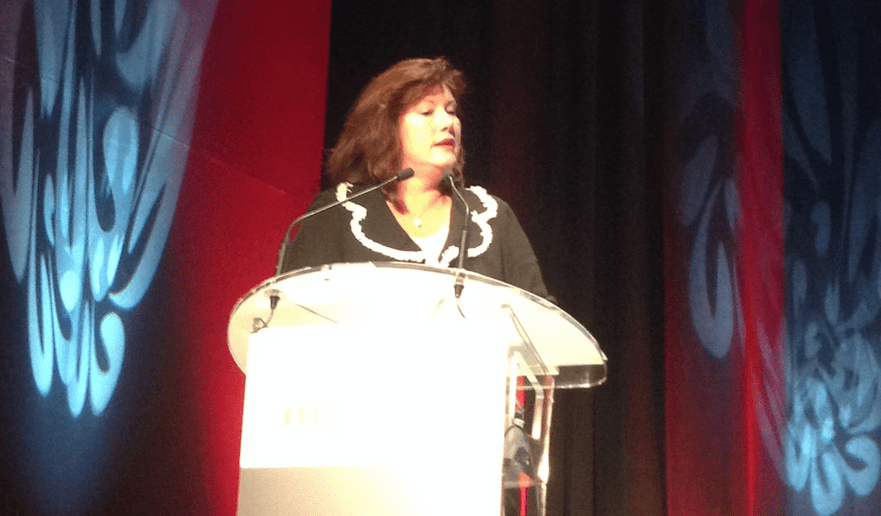Mary Shelton Rose, a partner at PwC’s US Entertainment and Media division, regaled us this afternoon with important consumption trends and insights on how social media, second screen and perceptions of advertising and packaging will actually propel the industry forward.
Because we can’t possibly share everything in this massive study, we’ll share just a few crucial details.
She began by sharing a trends chart of ad spend across multiple sectors, pointing out that average growth CAGR (compound annual growth rate) for internet advertising, internet access and video games will be about 5.6%.
However, “there is no individual segment that’s declining” globally. An exception to this is the US, where traditional publishing services are suffering a decline.
Demand is growing for TV subscriptions and licensing fees, and demand for certain types of premium content continues to grow.
TV advertising will grow 5.2% CAGR over the next 5 years, with the US continuing to dominate on account of sheer size, taking up 4.7% of that figure.
“The good news: TV is here to stay, and accordingly TV advertising’s here to stay,” said Rose, who cautioned that they are nonetheless seeing “meaningful” investment online, so the importance of strategising for fragmentation will grow.
But the news stays good. “Seeing TV and internet both growing means they’re complementary to each other and will continue to support, as opposed to cannibalise, one another” over the next 5 years, she said.
By 2017, OTT spend will remain small: only 6% of total pay TV revenues, nonetheless up from 2%.
This is where things start getting meaty.
PwC’s research finds that people are “employing a model where they have a subscription service and are satisfying premium content needs for that” while satisfying “other” needs with OTT offerings like Netflix.
So they’re keeping their cable operators. Even so, Netflix’s recent Emmy nominations are worthy of note. “Pay attention to the amount of funding going into the content at OTT… some of it is very high quality.”
She encouraged listeners to consider whether they’re making it worth customers’ while to keep a cable subscription over the long-term, pointing out that “90% of content viewing hours” on traditional television come from about 5 companies, who sell their content as a package.
There are other consequences to mass OTT adoption, dramatic ones: toward 2017, “we’ll see box office spending being greater than physical home video. We have not seen that before.”
Next she discussed customers’ willingness to pay for services and watch advertising.
Overall, there’s more pressure to make advertising relevant because people are starting to recognise the value of their own data, and sense what can really be done with that data. This actually makes standards higher. “They want to chose the type of ads they’re watching. So they’re willing to watch them, as long as it’s relevant,” said Rose.
In exchange, the amount of info people are willing to share is generous: 41-50% will let you see what they buy online, including name, income, birthdate, and email address.
But marketers are cautioned to cool their jets on mobile pings: a paltry 4-7% are willing to share their mobile history or receive mobile messages.
“People view that cell phone as their personal property and experience, and they’re very protective of it,” Rose explained.
As for social media, she had disappointing news: “Only 4% of people choose to watch a show based on social media buzz.” It is better to focus on the 59% of people that will watch something based on a recommendation from friends or family, she counseled.
The pay TV model must also change, because customers are increasingly insistent about wanting to customise their viewing experiences, in part to accommodate their OTT habits and align cable TV subscriptions to usage realities.
73% of people surveyed want to customise their package in some way or form. Customers, especially in the US, often complain about having 800 channels but only watching 20-30.
Still, they do want channels, and they are willing to pay for them. The degree to which either of these varies depends on the age groups.
“65% of people want at least 10 channels, with the older demographic wanting more. But people still want a lot of channels, not just one or two!” Rose said.
Across the group, almost 70% wanted to keep basic cable, and 67% want a premium subscription to accompany that. Sports are a big reason people stay with a subscription, and children’s programming is considered the least interesting motivation.
In terms of payment: 60% of people are willing to pay $3 per channel, but most people expected to pay $4-8 per channel. “That’s a nice margin,” Rose commented, but she added that people become a little vaguer about figures when they start thinking about how they’ll factor in their OTT subscriptions.
“People haven’t quite figured out what the total pricing package looks like,” she admitted, which leads to another interesting option: getting them to pay per show.
People are willing to pay around $2 per show per month, a figure that “gets interesting when you get people watching multiple content… and on multiple devices. It can add up.”
But she told the audience not to get caught up on numbers. “The most interesting point is (customers) starting to value individual pieces of content and individual channels. They’re thinking about (the shape of) their optimal package, what it would look like. They’re getting more granular.”
This of course puts more pressure on the industry to facilitate content discovery.
In terms of advertising, 8 in 10 customers want a customised package and are fine with watching ads in exchange, although the younger demographic is more receptive to this than older viewers.
60% said they’d be willing to watch 1-2 more ads on TV, and 58% said the same for online ads.
Tablet and mobile phone ad willingness, however, is much less (47% respectively): “The smaller the device gets, the less people are willing to consume ads on it,” said Rose, who encouraged us to consider this when doing mobile and geolocal ad campaigns.
47% of people continue to watch TV live. “They still want that live experience,” and then some: while binge viewing is up 10% (and will likely rise thanks to Netflix), it actually serves television at large: people consume a whole season, or multiple seasons, then want to watch the show live.
As for second-screen, numerous business models now exist with various objectives: control, discovery, reward, content-enhancement and multi-tasking.
Whatever your approach, five factors lead to a strong second-screen strategy:
1. Focus on the conversation. “The most important thing is it really has to be about the conversation itself. Not just about the shows or product, but about the conversation happening around” the content, said Rose. “We’re not in a linear world anymore, we’re in a fully-immersive, engaged model. ”
2. To be successful, networks, ad agencies, brands, and content owners, must cultivate an “omni-directional discussion” (collaboration). “It has to be a content community,” said Rose. Multi-channel cable operators are increasingly also participating in this discussion.
3. Harness the potential of superfan subscribers. Harvest superfans with rewards and use them: they’re a brand enhancer. “They’ll even take part in customer service,” Rose highlighted. “Use them to help you build a community.”
4. Respect customer privacy. Consider how people feel about mobile advertising; they hate it. We’re hearing a lot of seductive talk about “big data”, but use insights in a way that doesn’t feel intrusive to your customer. “Mobile phone and mobile devices are intensely private experiences, but you can leverage mobile interactivity without compromising that feeling.” The key is focusing on making it relevant and non-invasive.
5. Use new metrics to measure success. “We’re not at the point where we have great standards, like traditional Nielsen ratings, to measure online and offline activities,” Rose admitted, but “research indicates a multiplier effect: if you see content across multiple media, you’re also seeing multiple ads.” Being able to measure across platform campaigns is a priority that’s now being developed. “This will allow us to decide where to direct our content.”
What does this mean for business? Simply, that opportunities are there for companies who embrace change and look ahead. As we barrel toward 2017, remember that television has everything to gain from this brave new world.




